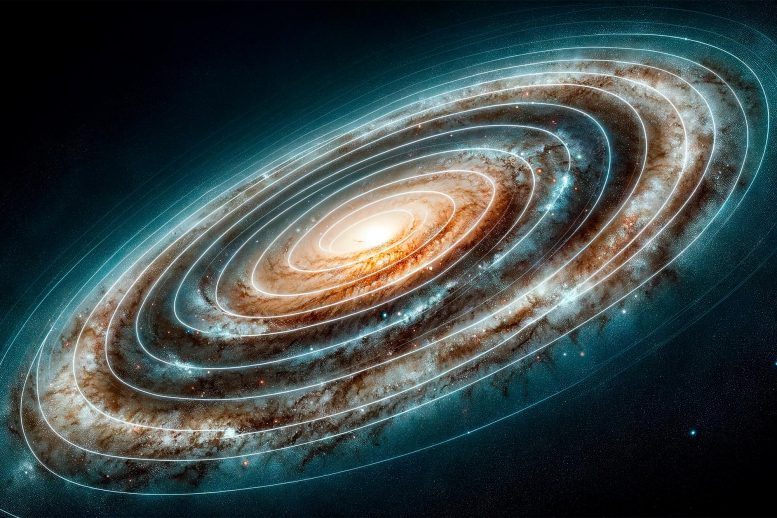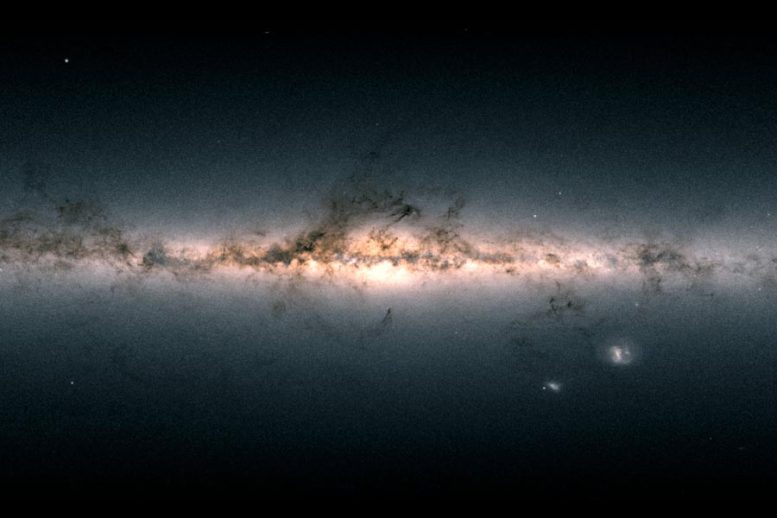
New research by MIT reveals that stars at the edge of the Milky Way move slower than anticipated, implying the galaxy’s core may contain less dark matter, challenging current astronomical theories. Credit: SciTechDaily.com
MIT’s study shows outer Milky Way stars rotate slower, indicating a lighter core with less dark matter, contradicting previous assumptions.
By clocking the speed of stars throughout the Milky Way galaxy, MIT physicists have found that stars further out in the galactic disk are traveling more slowly than expected compared to stars that are closer to the galaxy’s center. The findings raise a surprising possibility: The Milky Way’s gravitational core may be lighter in mass, and contain less dark matter, than previously thought.
The new results are based on the team’s analysis of data taken by the Gaia and APOGEE instruments. Gaia is an orbiting space telescope that tracks the precise location, distance, and motion of more than 1 billion stars throughout the Milky Way galaxy, while APOGEE is a ground-based survey. The physicists analyzed Gaia’s measurements of more than 33,000 stars, including some of the farthest stars in the galaxy, and determined each star’s “circular velocity,” or how fast a star is circling in the galactic disk, given the star’s distance from the galaxy’s center.
Understanding Galactic Rotation
The scientists plotted each star’s velocity against its distance to generate a rotation curve — a standard graph in astronomy that represents how fast matter rotates at a given distance from the center of a galaxy. The shape of this curve can give scientists an idea of how much visible and dark matter is distributed throughout a galaxy.
“What we were really surprised to see was that this curve remained flat, flat, flat out to a certain distance, and then it started tanking,” says Lina Necib, assistant professor of physics at MIT. “This means the outer stars are rotating a little slower than expected, which is a very surprising result.”

A study by MIT physicists suggest the Milky Way’s gravitational core may be lighter in mass, and contain less dark matter, than previously thought. Credit: ESA/Gaia/DPAC, Edited by MIT News
Challenging Dark Matter Theories
The team translated the new rotation curve into a distribution of dark matter that could explain the outer stars’ slow-down, and found the resulting map produced a lighter galactic core than expected. That is, the center of the Milky Way may be less dense, with less dark matter, than scientists have thought.
“This puts this result in tension with other measurements,” Necib says. “There is something fishy going on somewhere, and it’s really exciting to figure out where that is, to really have a coherent picture of the Milky Way.”
The team reports its results this month in the Monthly Notices of the Royal Society Journal. The study’s MIT co-authors, including Necib, are first author Xiaowei Ou, Anna-Christina Eilers, and Anna Frebel.
“In the Nothingness”
Like most galaxies in the universe, the Milky Way spins like water in a whirlpool, and its rotation is driven, in part, by all the matter that swirls within its disk. In the 1970s, astronomer Vera Rubin was the first to observe that galaxies rotate in ways that cannot be driven purely by visible matter. She and her colleagues measured the circular velocity of stars and found that the resulting rotation curves were surprisingly flat. That is, the velocity of stars remained the same throughout a galaxy, rather than dropping off with distance. They concluded that some other type of invisible matter must be acting on distant stars to give them an added push.
Rubin’s work in rotation curves was one of the first strong pieces of evidence for the existence of dark matter — an invisible, unknown entity that is estimated to outweigh all the stars and other visible matter in the universe.
Since then, astronomers have observed similar flat curves in far-off galaxies, further supporting dark matter’s presence. Only recently have astronomers attempted to chart the rotation curve in our own galaxy with stars.
“It turns out it’s harder to measure a rotation curve when you’re sitting inside a galaxy,” Ou notes.
New Insights From Gaia Data
In 2019, Anna-Christina Eilers, assistant professor of physics at MIT, worked to chart the Milky Way’s rotation curve, using an earlier batch of data released by the Gaia satellite. That data release included stars as far out as 25 kiloparsecs, or about 81,000 light-years, from the galaxy’s center.
Based on these data, Eilers observed that the Milky Way’s rotation curve appeared to be flat, albeit with mild decline, similar to other far-off galaxies, and by inference, the galaxy likely bore a high density of dark matter at its core. But this view now shifted, as the telescope released a new batch of data, this time including stars as far out as 30 kiloparsecs — almost 100,000 light years from the galaxy’s core.
“At these distances, we’re right at the edge of the galaxy where stars start to peter out,” Frebel says. “No one had explored how matter moves around in this outer galaxy, where we’re really in the nothingness.”
Weird Tension
Frebel, Necib, Ou, and Eilers jumped on Gaia’s new data, looking to expand on Eilers’ initial rotation curve. To refine their analysis, the team complemented Gaia’s data with measurements by APOGEE — the Apache Point Observatory Galactic Evolution Experiment, which measures extremely detailed properties of more than 700,000 stars in the Milky Way, such as their brightness, temperature, and elemental composition.
“We feed all this information into an algorithm to try to learn connections that can then give us better estimates of a star’s distance,” Ou explains. “That’s how we can push out to farther distances.”
The team established the precise distances for more than 33,000 stars and used these measurements to generate a three-dimensional map of the stars scattered across the Milky Way out to about 30 kiloparsecs. They then incorporated this map into a model of circular velocity, to simulate how fast any one star must be traveling, given the distribution of all the other stars in the galaxy. They then plotted each star’s velocity and distance on a chart to produce an updated rotation curve of the Milky Way.
“That’s where the weirdness came in,” Necib says.
Instead of seeing a mild decline like previous rotation curves, the team observed that the new curve dipped more strongly than expected at the outer end. This unexpected downturn suggests that while stars may travel just as fast out to a certain distance, they suddenly slow down at the farthest distances. Stars at the outskirts appear to travel more slowly than expected.
Exploring Galactic Mysteries
When the team translated this rotation curve to the amount of dark matter that must exist throughout the galaxy, they found that the Milky Way’s core may contain less dark matter than previously estimated.
“This result is in tension with other measurements,” Necib says. “Really understanding this result will have deep repercussions. This might lead to more hidden masses just beyond the edge of the galactic disk, or a reconsideration of the state of equilibrium of our galaxy. We seek to find these answers in upcoming work, using high resolution simulations of Milky Way-like galaxies.”
Reference: “The dark matter profile of the Milky Way inferred from its circular velocity curve” by Xiaowei Ou, Anna-Christina Eilers, Lina Necib and Anna Frebel, 8 January 2024, Monthly Notices of the Royal Astronomical Society.
DOI: 10.1093/mnras/stae034
This research was funded, in part, by the National Science Foundation.









“It turns out it’s harder to measure a rotation curve when you’re sitting inside a galaxy.”
Sure, whatever. Especially at the edges, right?
In 2019, Anna-Christina Eilers, assistant professor of physics at MIT, worked to chart the Milky Way’s rotation curve, using an earlier batch of data released by the Gaia satellite. That data release included stars as far out as 25 kiloparsecs, or about 81,000 light-years, from the galaxy’s center.
Based on these data, Eilers observed that the Milky Way’s rotation curve appeared to be flat, albeit with mild decline, similar to other far-off galaxies, and by inference, the galaxy likely bore a high density of dark matter at its core. But this view now shifted, as the telescope released a new batch of data, this time including stars as far out as 30 kiloparsecs — almost 100,000 light years from the galaxy’s core.
“At these distances, we’re right at the edge of the galaxy where stars start to peter out,” Frebel says. “No one had explored how matter moves around in this outer galaxy, where we’re really in the nothingness.”
This MW size is twice what everyone was raised on. Everyone was told the MW had a size of around 100k light years, a number that is still in frequent use by the mainstream media.
The ideal DM distribution target for a face-on spiral has always resembled to me a rippled or “target” shape, once the gravity of the arms is subtracted. No one is interested in doing that, however, just as no one was interested in confronting Eddington with dark matter, considering he did such a bang-up job with his precession “predictions.”
A second “ripple” in the DM effect might be the difference in MW size for making the jump from 100kly to 200kly in diameter there. A second ripple with the appropriate size is a big hindrance to blaming a peripheral maximum on a simple BH hot core mass ejection characteristic.
I’d sum this up by saying I can’t think of anything more pathetic than being forced to assign a “clumpiness” value to that which amounts to nothing but a ripple pattern. Big Sorry to the super-determinists out there.
Cite: ALMA Measurement of 10 kpc-scale Lensing Power Spectra towards the Lensed Quasar MG J0414+0534
A Centre piece turning a short leash with a second center with a longer leash a third piece with a longer still leash and so on.Would look like they run at different speeds but!!!!
The basic difference in the measurement rotation of stars,treated as visible matter is that,distance is calculated from the event horizon of the supermassive black hole;thus for all stars velocity is constant with respect to the SMBH.But,in practical,measured from the earth,velocity must be proportional to mass of the star expressed in unit of solar mass,can again rationalised to a constant velocity.
Dark matter circular velocity is a vector effect of gravity in interaction with normal visible matter,measured with modification as specified.
Constant velocity of stars arouñd the supermassive black hole in galaxy referes to their unique bàĺanced gravitational force with SMBH in case of normal visible matter.
So,the described vector effect of dark matter gravity in the form of constant circular velocity is interpreted.
Well if the main stream media is using it, it must be true.
Here,circular velocity of stars are changing from a constant value with distance in the context of dark matter,found the amount less than that from findings of Vera Rubin.What had been observed by Vera Rubin for DM is five fold of present time measured amount.The reason for such variation is coming from difference in the measurement of circular velocity of stars due to dark matter.
So,gross understanding on DM is insufficient or not complete rather than being wrong,as per the facts described here.
Circular velocity of stars is a concept followed in the treatment of dark matter is not cicular exactly.
The rotation of stars around the supermassive black hole is a discovery (Patel’s) Law of rotation is based on rotation of a galaxy with others.This law is applied to natural visible matter.
The (Patel’s) Law of Rotation and Star Dynamics states that rotation of all stars is equal to the Gravity of Supermassive black hole at the center of Galaxy.
So,in the experiment described here,the value of dark matter figured out is nearly proportionate to the the value of visible matter to the actual amount of dark matter present.So,thanks to the authors for such good study,this way.